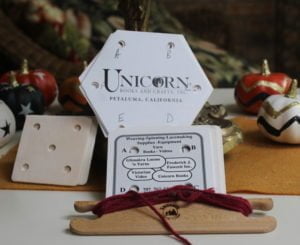Do you want to try something different?
You saw the tablets/cards at the Contemporary Handweavers of Texas conference and wondered what are they and why are they at a weaving conference? You purchased a deck or someone gave you a set of cards and now wonder what to do with them? You tried card weaving but didn’t care for the back strap method to keep tension on warp? Did you wonder what else you could do with your Inkle and rigid heddle looms? What are S and Z and, up and down, and why are they important? How do you create patterns for card weaving?
Card or Tablet Weaving is an ancient craft in which simple cards or tablets form the loom. Yarns are threaded through the holes in the set of cards. These cards are rotated to create the pattern. The cards or tablets have been made from a wide variety of materials, such as cardboard, playing cards, beer coasters, cereal or food boxes, paint and laminate samples, wood, bone, and circular saw blades (not recommended).
Triangle Loom Weaving or Continuous Strand Weaving Method
Did triangle loom weaving start in the 1970s or earlier? How did poor people weave during middle ages and Roman time? What can I do with a triangle shape piece of cloth? What was the woman doing at the back of the Vendors Area at Contemporary Handweavers of Texas Conference? Is it true I can make back the price of the triangle loom on my first piece?
Continuous strand weaving method is a method of weaving where the warp and the weft are one continuous strand. Unlike conventional weaving where the warp threads are measured, cut, and threaded onto the loom, and the weft wound onto shuttles, continuous strand requires none of this preparation.
Kerry Mulloy will discuss and demonstrate both of these methods at the October meeting. Although Kerry was exposed to weaving in 1990s, he only has been weaving since he retired in October of 2016.



